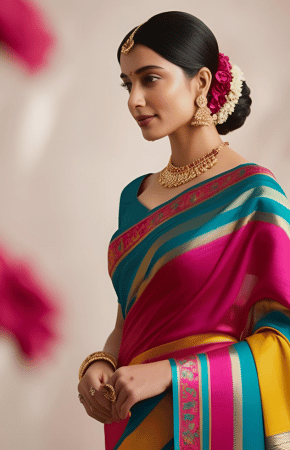When shopping for sarees, you often come across two major categories—handloom sarees and machine-made sarees. While both have their charm, they differ in quality, craftsmanship, and sustainability. In this blog, we will compare handwoven sarees vs. machine-made sarees to help you decide which one suits your needs best.
1. Craftsmanship & Weaving Process
🧶 Handloom Sarees:
- Handwoven by skilled artisans using traditional techniques.
- Unique patterns and intricate detailing, often taking days or weeks to complete.
- Each saree is slightly different, making it one-of-a-kind.
⚙️ Machine-Made Sarees:
- Manufactured using power looms and automated machines.
- Perfectly symmetrical patterns but lack the artistic variations of handloom sarees.
- Can be mass-produced in bulk within a short time.
🔗 Shop Authentic Handloom Sarees
2. Fabric Quality & Texture
✔ Handloom Sarees:
- Made from high-quality natural fibers like silk, cotton, or linen.
- Breathable and softer with time.
- Slight irregularities in weaving add to their beauty and authenticity.
❌ Machine-Made Sarees:
- Often use synthetic fibers or blended fabrics.
- Smooth and uniform texture but may feel less luxurious than handloom sarees.
- Less breathable, making them uncomfortable in extreme weather.
🔗 Explore Pure Silk Handloom Sarees
3. Durability & Maintenance
🔄 Handloom Sarees:
- Can last for decades with proper care.
- Require gentle handwashing or dry cleaning.
- Need to be stored carefully to maintain their texture and sheen.
🔩 Machine-Made Sarees:
- More resistant to wear and tear.
- Easy to maintain and wash at home.
- May lose shine and softness over time due to synthetic fibers.
4. Sustainability & Eco-Friendliness
🌍 Handloom Sarees:
- Environmentally friendly as they are made with minimal use of electricity.
- Biodegradable due to natural fibers.
- Support rural artisans and promote sustainable fashion.
🏭 Machine-Made Sarees:
- Often produced using synthetic materials and chemicals.
- Contribute to pollution due to industrial production processes.
- Less sustainable as they involve mass production.
5. Price Comparison
💰 Handloom Sarees:
- More expensive due to intricate weaving and manual labor.
- Prices range from ₹2,000 to ₹1,00,000+, depending on the craftsmanship and fabric.
💵 Machine-Made Sarees:
- Budget-friendly and widely available.
- Prices start as low as ₹500 and go up to ₹10,000+ for designer variants.
🔗 Find Budget-Friendly Handloom Sarees
6. Best Occasions to Wear
🎉 Handloom Sarees:
- Weddings & traditional ceremonies.
- Cultural events & festive occasions.
- Office wear for a sophisticated look.
🌆 Machine-Made Sarees:
- Casual daily wear.
- Office wear for a professional appearance.
- Party wear with modern prints & embellishments.
🔗 Shop Wedding Handloom Sarees | 🔗 Explore Party Wear Sarees
Final Verdict: Which One Should You Choose?
💎 If you value authenticity, craftsmanship, and sustainability, handloom sarees are the perfect choice.
🏭 If you prefer affordable, easy-maintenance sarees for daily wear, go for machine-made sarees.
No matter what you choose, sarees are timeless and elegant. Browse our exclusive collection of handloom and machine-made sarees to find your perfect match!
🔗 Shop Now at ShammahDrapes
FAQs on Handloom vs. Machine-Made Sarees
Q1: How can I identify a real handloom saree?
Handloom sarees have small weaving irregularities, a soft texture, and a handmade label or certification.
Q2: Are machine-made sarees less durable?
Yes, they may lose shine and texture faster than handloom sarees, especially if made from synthetic materials.
Q3: Which saree is better for daily wear?
Machine-made sarees are easier to maintain, but cotton handloom sarees are also great for everyday wear.

